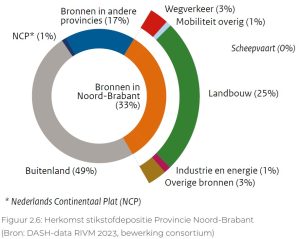The province is working to reduce nitrogen emissions and precipitation via two parallel tracks: 1) the Brabantse Ontwikkelaanpak Stikstof (Brabant's Nitrogen Development Approach) which focuses on generic measures for Brabant to bring down the nitrogen blanket and 2) green-blue area-based approach for 11 of the 18 nitrogen-sensitive Natura 2000 areas with local measures within their sphere of influence. For both tracks, the knowledge consortium will take care of calculating the measures developed on reducing ban nitrogen precipitation.
Brabant-wide measures
Insight into the origin of nitrogen precipitation for 2021 as reference year indicates that 33% comes from Brabant itself, which immediately shows the sphere of influence of the Brabant approach.
Expertise and data on actual animal numbers from the agricultural census (Wageningen University), number of permitted animals from the permits (Pouderoyen-Tonnaer), expertise on mobility and industry and the calculation tool AERIUS (Wing EMC) are combined. The starting point for predictions for 2030 is the Climate and Energy Outlook (2021), but it has been refined for field and barn emissions for Brabant. To provide insight into the knobs that can be turned, different scenarios were developed: with field correction for poorly functioning stables, maintaining derogation and a 10% reduction of emissions from livestock in a 3 km zone around Natura 2000 areas. The different scenarios show that the proposed measures for Brabant are a step in the right direction, but insufficient to reach the target range. The Province is now developing an additional package of measures.
Area-based measures
Currently the knowledge consortium is working on the effects of area-focused measures, partly this is already included in the effects of Brabant-wide measures that also affect the areas. Local measures that are calculated for areas differ from the effect of participation in buy-out schemes, extensification via a grassland standard, feed and management measures to making x number of (recreational) houses more sustainable at y distance from a Natura 2000 area, planting trees to capture nitrogen around Natura 2000 areas and realizing the Brabant Nature Network by converting and removing parcels from fertilization. This analysis phase is now underway, in which Wing is supervising four subareas; Brabantse Wal, Grenscorridor, Kempenland-West and the Westelijke Langstraat.


